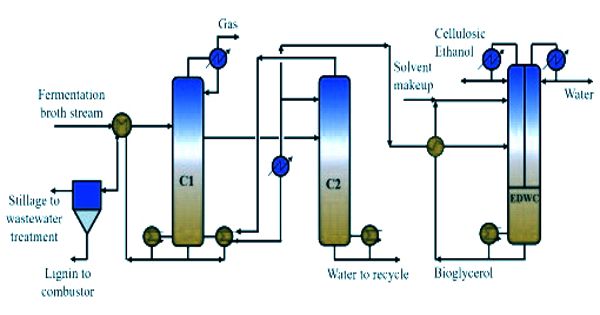The basic task of depositing a check at the bank drive-through quickly turned into the kind of “aha” moment typically only seen in fiction.
Researchers at Georgia Tech have been developing a concept to streamline conventional direct air capture (DAC) devices. In order to capture CO2, their method drew air through a novel type of coated carbon fiber using ambient wind velocity. That would do away with the intrusive fans found in many systems. Additionally, the efficiency could be increased by fast heating the carbon fiber strands to liberate the trapped carbon dioxide with little heat loss.
But they were struggling with how to deploy these new sorbent-coated carbon fibers for maximum effect.
“I had to go deposit a check at the bank, and I went through the drive-through. They had the old pneumatic tubes that come down to transport documents,” said Ryan Lively, Thomas C. DeLoach Professor in Georgia Tech’s School of Chemical and Biomolecular Engineering (ChBE). “There are not many times you have a light bulb moment in your career, but I saw the tubes and I realized, we could put the fibers in something like a bank teller tube canister.”
“That’s pretty much what we did, and it worked.”
The group started testing its system after installing the modules that were inspired by pneumatic tubes. They discovered that they could manufacture carbon dioxide with enough purity for underground storage while avoiding many of the significant upfront costs associated with constructing conventional DAC systems. They described their design and approach in the June 21 issue of the journal Joule.
“This work not only conceptualized a new generation of DAC systems but also showed practical operations of our invention to some extent,” said Won Hee Lee, the paper’s first author and a former postdoctoral scholar in Lively’s lab. “We already successfully captured ambient CO2 with our lab-scale module. Now it’s important to scale up the module. Since all the components of our system are commercially available and fabrication is relatively easy, there should be few technical hurdles to making the module in large scale.”
The team has carried out that scale-up, at least conceptually, by extrapolating the economics of a real-world system from their experimental data. They discovered that the system may capture CO2 for $150 to $200 per ton, which is much cheaper than the expected cost of $300 to $600 per ton for currently under development commercial systems.
The fibers are very, very uniform. When you hook all this up to an electrical system, you distribute that energy remarkably homogeneously, which is unusual for a resistance heating system. We’re not the first to think of resistance heating to regenerate a carbon capture device. But typically, the heating was either slow or not uniform. There are places where you’re heating up the air instead of the thing you’re trying to heat.
Ryan Lively
A Simpler Approach
The study’s co-authors include researchers in ChBE who’ve positioned Georgia Tech as a leader in direct air capture technology. Professors Christopher Jones and Matthew Realff work with Lively on the full spectrum of DAC, from the molecular to the systems level.
This work presents two key advances.
DAC systems use heat to release CO2 from saturated filter materials. The CO2 is collected and can either be piped underground or used to create chemicals or fuel. System heating often comes from an outside source.
Because it is rapid and effective but also destructive and necessitates an additional condensing process, steam is a popular alternative. These systems are big and expensive because insulation is needed to keep all that heat from escaping.
Unique carbon fiber strands covered with a carbon-loving sorbent were developed by Lively and his team. As the carbon fiber core warms up from the inside out, the heat is distributed quickly and uniformly.
“The fibers are very, very uniform. When you hook all this up to an electrical system, you distribute that energy remarkably homogeneously, which is unusual for a resistance heating system,” Lively said. “We’re not the first to think of resistance heating to regenerate a carbon capture device. But typically, the heating was either slow or not uniform. There are places where you’re heating up the air instead of the thing you’re trying to heat.”
The researchers’ system uses fewer components overall. In order to trap CO2 no matter which way the wind blows, the design deploys a number of their bank-tube-inspired modules with carbon fiber strands in a circle.
During the regeneration phase, the system uses a single vacuum pump that rotates from module to module. To release the CO2 and “recharge” the strands, there is also no need for steam generators, pumps, or condensers. The system is now simpler overall and less expensive to design and deploy as a result of both of these modifications.
“The capital cost of this system is significantly lower than many of the current DAC systems based on the lack of auxiliary systems like steam generation,” Realff said. “The energy cost is still a challenge, and we need to increase the amount of CO2 we can adsorb in the device so that the sensible heating of the fibers does not consume too large a portion of the overall heat.”
But Realff said the rapid heating and fast cycling of the system holds great promise for a more productive approach to direct air capture: “The fact that we could produce a working prototype and demonstrate it at bench scale in months is a remarkable feature of the technology.”
The team’s DAC system should ideally be located near a wind farm so that it can harness the renewable energy produced by wind turbines. Reallf’s analysis revealed that the team’s solution will still remove enough CO2 from the atmosphere to be carbon negative even while using energy from the existing grid.
Another advantage to the team’s approach is the carbon fiber strand. The substance is affordable, easily accessible, and sustainably produced in huge quantities. It also possesses the correct mechanical and electrical qualities.
Now the team is looking to boost the quality of the cardon dioxide they can produce. They have attained 80% purity, which is sufficient for underground storage, but they would like to reach the 99% purity required for useful reuses like the production of chemicals or fuels.
With that objective in mind, they are collaborating with the Georgia Tech Research Institute to improve and automate their system, and they are working toward mounting a test system atop a campus building.
“I have worked on DAC for over a decade, and almost all designs I have seen rely primarily on heat energy for desorption,” said Jones, who also is ChBE’s John F. Brock III School Chair. “A technology that allows for both rapid, local heating and use of renewable electricity expands the DAC technology developer’s array of design options.”
















